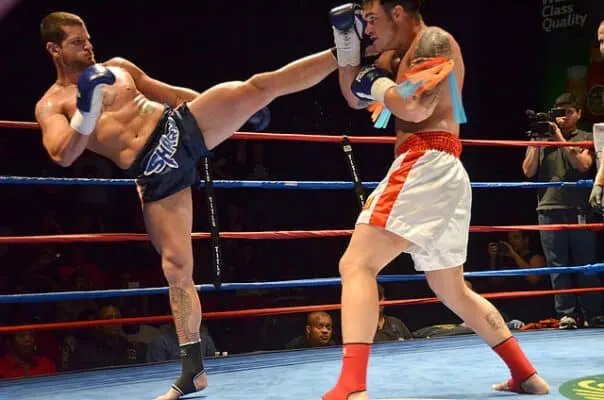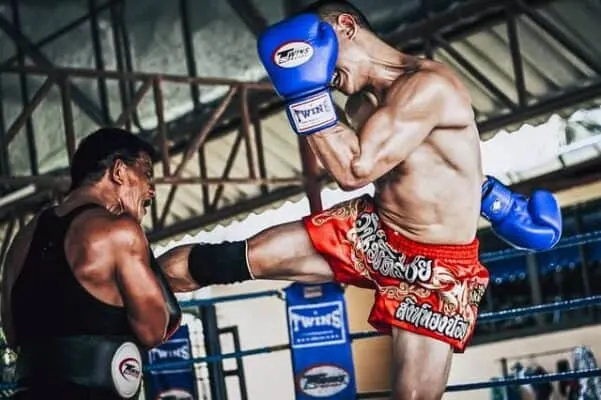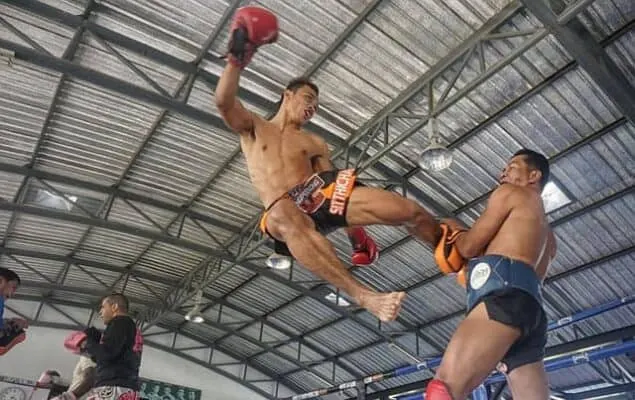
Muay Thai, sometimes referred to as the deadly art of eight limbs is regarded as one of the most dangerous striking martial arts on the planet, but is it effective for self-defense?
Muay Thai is a very effective self-defense system that focuses on delivering powerful strikes using the limbs of your body to end a fight quickly, which is very important in self-defense situations to get away quickly and safely.
Muay Thai traces its roots from Muay Boran and other ancient forms of southeast Asian kickboxing-style arts where rules were few, but is it useful on the streets of today? Well, the short answer is yes as mentioned above, but the long answer is it depends. Keep reading to find out!
What Does Muay Thai Teach?
The slightly more “sanitized” sport version of the Muay Thai equips a focused student with powerful punches, devastating kicks, sharp knees and elbows, as well as standing grappling techniques used to help aim those knees to the mid-section and set up leg sweeps. These attacks, along with various blocks are typically practiced on pads and bags before students develop them further in sparring bouts. Sparring helps hone footwork, distance management, balance, timing and precision.
Some Krus(teachers) will also look at the Muay Boran techniques still utilized by the Thai military, including eye gouges and throat strikes. However, this is a little bit less common, as most gyms ultimately want to produce a stable of successful professional fighters who fight under various rulesets.
Even less common are schools which teach various Thai weapon arts such as Krabi Krabong.
Krabi Krabong is a Thai weapons-based martial art that trains you to utilize any objects as weapons in self-defense situations.
Ultimately learning to protect the head and vital organs, how to relax under pressure and move decisively will serve most people well, providing them with increased confidence and calmness in a self-defense situation.
LEARN MORE Check out our article on 21 Rare Weapon Based Martial Arts You Have Never Heard of
What are the Pros and Cons of Muay Thai for Self Defense?
The Pros
Muay Thai offers a wide variety of benefits to the practitioner for self-defense. In almost all situations where self-defense is required, it is best to find ways to extricate yourself from danger. When the flight or fight reaction calls, opting for flight should be regarded as the smart way of doing things, rather than the cowardly way. However, running isn’t always an option. Sometimes we may be unfortunately facing off against a multitude of assailants, don’t have the space to run, or have to protect our loved ones from dangerous people.
Having the skills to protect the head from strikes, as well as the footwork to evade them are probably the most important ones which Muay Thai lessons can teach.
When faced with multiple attackers and you are forced to stand, it may be necessary to incapacitate one assailant to lower the number of approaching threats. Muay Thai can be incredibly aggressive and knowing how to throw elbows or knees – two of the strongest and sharpest weapons the body with power and precision can allow you to incapacitate someone with relative ease.
By knocking out, winding, or causing severe cuts to someone’s face, you may not only remove them as an attacker, but unsettle their accomplices, causing them to approach with caution. This can buy you time to make an escape.
Training Muay Thai should guarantee a massive improvement to your cardio, so running is something which should be more manageable. Additionally, due to the catharsis and the mental clarity from the highly active meditation hitting pads or bags can bring, Muay Thai practitioners often tend to be more confident and composed. Confident people are often less likely to be targeted by bullies, while the mental clarity should lead to better decision-making processes.
The Cons
Muay Thai has a few drawbacks as a form of self-defense. Firstly, as it is a sport, most practitioners will have done most of their training while wearing gloves that protect the fragile bones of the hand. This may give the student false confidence in the sturdiness of their hand. Punching someone with a bare-knuckle can lead to a broken hand, which isn’t much use in a fight, can be a source of immense pain and some pricy medical bills.
Kicks also have their limitations. While leg kicks and sweeps are usually unexpected and can cause an attacker to fall, or limp, anyone throwing a body or head kick can risk becoming unbalanced and falling themselves. Like the glove situation, most Muay Thai fighters practice sparring with shin guards on and may not be used to landing kicks without them, or are they unlikely to be used to throwing kicks with shoes on, which in a self-defense scenario is almost always more likely. These alterations in the mechanics of the techniques can be subtle, but lead to complications.
As mentioned before, unless you train Krabbi Krabong, or the various forms of Muay Boran practiced by the Thai police or military, you are unlikely to have much interaction with weapons. Other martial arts such as Krav Maga will be more likely to teach weapon disarms, along with the mentality of recognizing items in any given scenario which can be utilized as a makeshift weapon. Muay Boran and Krav Maga will also teach dangerous but sometimes necessary self-defense moves such as throat strikes and eye gouges. Regular Muay Thai classes won’t teach these.
One unexpected drawback is that Muay Thai can instill some people with too much confidence. Some people who have studied the art may end up provoking someone in a situation, when this situation could be easily diffused. Similarly, they approach a street scenario with a professional, or amateur fighter mentality. Rather than shouting for help, or looking for an exit, they can seek to “win”. Fighting usually involves getting hurt and even if you aren’t hurt, badly injuring or even accidentally killing someone due to them falling badly or receiving brain trauma can at the very least involve an expensive lawyer, undue stress, guilt and PTSD. This is all before we mention the very real threat of prison time.
Lastly Muay Thai doesn’t teach any ground fighting. A huge amount of street and bar fights end up on the ground and knowing how to grapple, to either get back to your feet, or to neutralize an attacker will serve any combatant. Wrestling or Brazilian Jiu-Jitsu is much more important in these scenarios.
RECOMMENDED FOR YOU: Are U.S. Police Trained in Martial Arts? Police Training Q&A
Is Muay Thai Hard to Learn?

Whether Muay Thai is hard to learn depends on a number of factors, such as age, mobility, coordination, stamina and balance. The good news is that other than age, the vast majority of Muay Thai students will find that these things improve over time.
The bad news is that learning techniques can be challenging. Developing the muscle memory needed to throw strikes with power, speed and precision can require an enormous amount of concentration, along with an openness and willingness to learn.
Certain attacks will require more concentration and resilience to develop. Switching stance to throw powerful kicks from the lead leg can sometimes need hundreds and thousands of repetitions to get to a high standard. However, compared to other striking martial arts such as Karate and Taekwondo, Muay Thai Krus(Muay Thai instructors) don’t tend to spend as much time on focusing on flashy kicks which need bouncy footwork to set up.
Nak Muays(Muay Thai fighters) may be flatter footed than other martial artists, but most of the moves are easier to learn because they are more simplistic. As one Kru said “Muay Thai is like opening a cupboard and catching something falling from it before it smashes on the ground”. It is often reactionary and can feel significantly more natural.
Most combinations begin with punches, which most people are generally more comfortable throwing than kicks. While it will take a while to develop an efficient jab, cross or hook, humans have been turning their hands into clubs and whacking each other across with said clubs since the stone age.
As with many other new skills, the hardest part of Muay Thai can be starting, losing the ego and accepting that initially, we will be bad at the new skill. It takes time, repetition and perseverance to develop efficiency and knowledge. Thankfully, for most people, Muay Thai is a fun, often social but in a way, meditative and cathartic skill to learn.
RECOMMENDED FOR YOU: Is BJJ Hard To Learn? A Guide For Beginners
How Often Should You Train Muay Thai?
How often we train Muay Thai comes down to age, tie, fitness levels and intended outcome. For the average healthy adult, training 2-3 times a week should be enough to see the benefits. In the early stages its advisable to give the body plenty of time to rest. Striking arts can be hard on the joints, bones and sometimes shins.
Recovery time is required as the body adjusts to new routines in order to avoid excess strain or risk of pulling muscles. Over time students may find themselves with more energy and enthusiasm making training a tempting and more manageable proposition. Professional fighters will train as often as twice a day, six days a week.
Be conscious of your other commitments. As fun and benefitting Muay Thai can be, it is wise to avoid burnout.
How Long Does It Take to Become Good at Muay Thai?

It goes without saying that everyone learns at different speeds, for all sorts of different reasons. Some people are more naturally athletic, whilst some suffer from disabilities or developmental issues that can affect coordination, such as dyspraxia.
That being said, the average person training Muay Thai two or three times a week should see improvements and muscle memory enhancements within a few months.
Arguably the most important fundamentals Muay Thai can provide for self-defense can develop in a few months. Knowing how to guard, block punches and kick is something that can be developed quite quickly, either through sparring or through pad holders who test or “check” the guard through tapping the boxer when they fail to maintain their guard. If the student regularly practices Muay Thai, they should undoubtedly see leaps and bounds in their cardiovascular health levels. With improved cardio, comes an improved ability to run away from a dangerous situation.
It can take years to get to a true proficiency i.e. to get to a good standard of competition level Muay Thai. Some students will compete on an interclub, or low-level amateur level within a year, but to become a professional, it requires years of discipline and dedication.
Do You Get a Belt In Muay Thai?
Colored belts that signify the level of ability or experience as found in martial arts such as Karate, Taekwondo, Judo or Jiu-Jitsu don’t exist in traditional Muay Thai classes. A Muay Thai master may give a student a colored armband as a good luck charm before they enter into a professional bout and some western gyms or franchises have been giving colored versions of these bands to communicate a rank, but this isn’t the norm. Some traditionalists may even consider this as a gimmick.
Instead Muay Thai is more akin to Western Duke of Queensbury pugilism and respect is earned when a fighter wins amateur or professional fights. In Thailand, the highest regard would be held for “stadium champions”, who would be the most dominant and successful fighters in their given weight classes at the likes of Lumpinee or Rajadamnern Stadium.
RECOMMENDED FOR YOU: Why Is Boxing Called The Sweet Science? – Ultimate Answers
Muay Thai vs BJJ – Which Is Better For Self-Defense?
This is quite a tough question and is often situationally dependent. If you are forced to defend yourself from only one unarmed attacker, Brazilian Jiu-Jitsu(BJJ) is arguably much more useful. By grappling, or taking someone to the ground, you often negate any speed, strength or size advantages they have. Removing the threat of either having to strike or being struck can greatly reduce risk of long-term damage for you and your assailant, thereby keeping you safe from both injury, death and legal repercussions.
On the other hand, going to the ground with one aggressor as their friend’s stamp on your head isn’t a wise move. Muay Thai with its strikes can help you handle multiple attackers or create the space to escape from a dangerous scenario. Muay Thai, which often has running as a warm-up, will also be more efficient at developing cardio useful for making these escapes.
LEARN MORE Get the full report on BJJ vs Muay Thai – Which Style Is Better? FAQ
Closing Thoughts
Muay Thai is an exciting and engaging sport for both the practitioner and one which provides many benefits for self-defense. It is undoubtedly one of the most fun ways to get into shape and simply by being in shape, we can be in a better position to handle threats presented to us.
Wherever possible, it is great to cross-train in a grappling art, or in a discipline which factors weapons into dangerous scenarios. It is arguably even better to train how to diffuse dangerous situations, or to have the awareness on how to avoid them entirely. It is also wise to avoid becoming overly confident in our abilities and knowing the weaknesses Muay Thai has should add some caution with the way we interact with danger.
